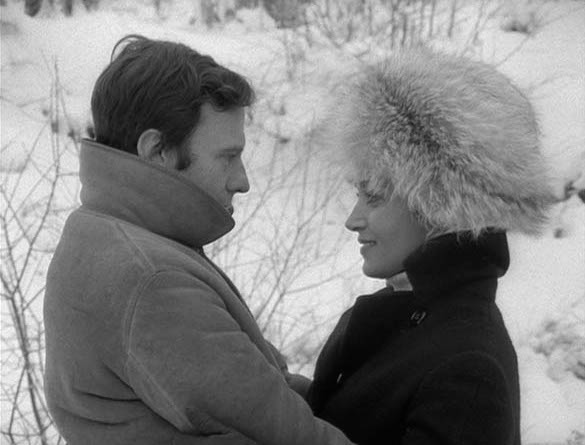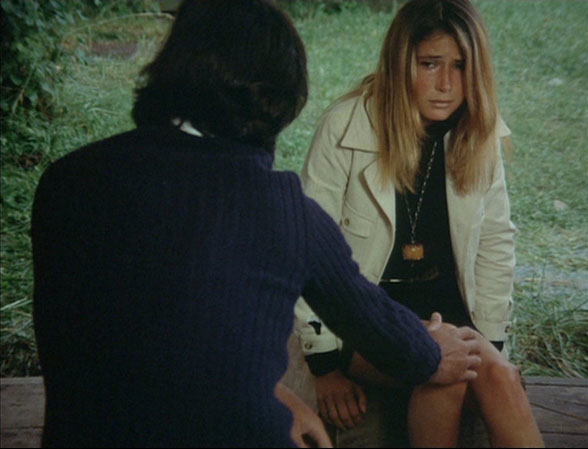My immediate response to the news of Eric Rohmer’s death was the keen regret that there would be no more Rohmer films, and thus no more of those surprises he was still, at nearly 90, thoroughly capable of eliciting. Indeed, his last three films (The Lady and the Duke, Triple Agent, The Romance of Astrea and Celadon) were among his most surprising, period films that ventured into political tragedy and pastoral comedy in ways that opened up new dimensions in his earlier work. Few filmmakers have been able to develop a body of utterly personal work so deliberately and methodically, and he managed it only with the most extreme budgetary discipline.
That he made small-scale films on small-scale themes (like love and trust and betrayal and self-knowledge) made him seem to many a minor master—words like “soufflé” and “bouquet” had a way of cropping up in descriptions of his films. The very pleasures his movies were full of—pleasures of youth and landscape and leisure, however little pleasure the worry-ridden characters derived from them—seemed perhaps too easeful, too much like relaxation, in the same way that Bonnard’s paintings might once have seemed too luxuriously beautiful.
I think it will become clear that Rohmer was one of a handful of really great filmmakers of the last half-century. I can’t think of a greater. His movies will be seen as aspects of a single enterprise in how they reply to one another and how each further variation deepens the effect of what came before. The rigorousness with which their pleasures are achieved will become more apparent if all the films are seen together. The near-absence of background music in Rohmer’s films has often been remarked on (although on closer examination the work is filled with illuminating fragments of ambient sound, musical and otherwise)—but symphonic underscoring was unnecessary in films so musical in their rhythms. He makes his own music with time itself. Likewise his notoriously dialogue-filled movies, from My Night at Maud’s and Claire’s Knee on, are perhaps most remarkable for their evocation of silence. There is no pause like a Rohmerian pause.
Even if there are to be no more of his movies, there will still be surprises. These are works designed cunningly to resist settling into any final form. They change between viewings. In his work with actors, Rohmer created characters who exist beyond the requirements of their particular intrigue—they persist even when offscreen. To go back to, say, Autumn Tale—the last and most elaborate of his masquerades of love—is to wonder again at the ultimate unknowability of those people who seem at the same time so familiar, not least because we may have seen them in other scenes in other corners of the Rohmer universe. Impossible to contemplate Béatrice Romand without having in mind her teenage self in Claire’s Knee almost thirty years earlier, or to imagine Marie Rivière as the ostensibly contented provincial wife without remembering the chronically unhappy Delphine of The Green Ray.
These are performances that seem not to be such, even as Rohmer’s scenarios proclaim their artifice, an artifice that would have worked just as well in the seventeenth century. At any moment in any Rohmer film there is tension between the literary structure of a narrative—even if it turns out to be a narrative in which nothing quite seems finally to have happened—and the filmic there-ness of real people in a real place in real time. In Autumn Tale we are, at any moment, equally absorbed by the twist of a devious plot, the personalities (as gauged from faces and gestures and voices) of people who are in equal measure characters and actors, and the “everything else” in which they exist, embodied by, for instance, a bunch of grapes on the vine, suddenly brought to the center of our attention. The grapes are as important as anything: with time, Rohmer’s films will also be seen as a documentation of mutating or altogether vanishing environments.
Undoubtedly we will learn more about the life that Rohmer worked very hard to keep private, and books will be written to connect the peculiarities and obsessions of the films with biographical data. But the mysteriousness will remain, even more mysterious for springing up in work so marked by rationalism and knowing wit. The banal is finally made strange. The more his characters are plainly revealed the more enigmatic they become. The “green ray” (out of a Jules Verne novel) that brings at least the promise of love at the end of that film (perhaps his most vibrant) is paralleled by the “blue hour” that casts an unearthly spell over the first episode of his lesser-known Four Adventures of Reinette and Mirabelle, so cheaply made that at moments it has the air of a home movie. The Latin liturgy that ends Perceval le Gallois (that extraordinary exercise in total translation) rhymes with the French liturgy at the beginning of My Night at Maud’s. Yet nowhere in all this work are we released from endless questioning and doubting—starting with our doubts about our own motivations and desires, not to mention our interpretation of the evidence before us.
Advertisement
Rohmer’s work will be around to contemplate for a long time—to contemplate with endless curiosity and pleasure—or so one would like to think. There is much that hovers near unavailability (Autumn Tale has never been released on DVD), and one crucial work never available in the U.S., his first film, The Sign of the Lion, which is among many other things a haunting documentary of Paris in the summertime. One could even hope to see the rarest of rarities, his video version of Heinrich von Kleist’s play Käthchen von Heilbronn, as staged by Rohmer (in his own translation) in Nanterre in 1979. Now there is a work to call forth mysteries, with its blend of obsessive love, oneiric prophecy, and imperial politics, and at its center a young girl stubbornly resistant to all forms of reasonable persuasion.




